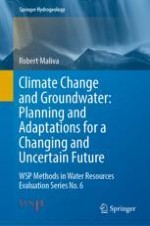This book attempts to bridge the gap between the climate change research and decision-making communities by exploring the impacts of climate change on groundwater from a more applied perspective. Global climate change will impact groundwater demands, quality, and available supplies, and rising sea level may cause water tables to rise, inundating low-lying coastal areas. Groundwater will increasingly be needed to perform a stabilization role in mitigating fluctuations in the supply of surface waters, serving as a buffer against droughts. Climate change has become a frequent subject in the mass media, and the academic literature on the subject is now enormous. An impediment to climate change adaptation with respect to water is a poor link between the climate change research community and the actual decision-makers responsible for water supply planning. Key issues explored are methods for evaluating potential impacts on climate change on local groundwater systems, the adaptation of decision-making process, and how climate change adaptation can be mainstreamed into the water supply planning.
